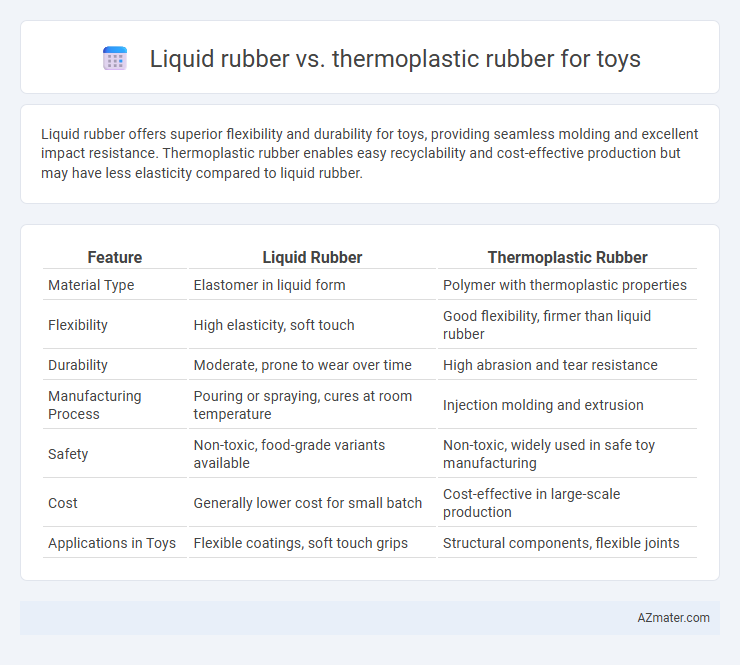Liquid rubber offers superior flexibility and durability for toys, providing seamless molding and excellent impact resistance. Thermoplastic rubber enables easy recyclability and cost-effective production but may have less elasticity compared to liquid rubber.
Table of Comparison
| Feature | Liquid Rubber | Thermoplastic Rubber |
|---|---|---|
| Material Type | Elastomer in liquid form | Polymer with thermoplastic properties |
| Flexibility | High elasticity, soft touch | Good flexibility, firmer than liquid rubber |
| Durability | Moderate, prone to wear over time | High abrasion and tear resistance |
| Manufacturing Process | Pouring or spraying, cures at room temperature | Injection molding and extrusion |
| Safety | Non-toxic, food-grade variants available | Non-toxic, widely used in safe toy manufacturing |
| Cost | Generally lower cost for small batch | Cost-effective in large-scale production |
| Applications in Toys | Flexible coatings, soft touch grips | Structural components, flexible joints |
Introduction to Liquid Rubber and Thermoplastic Rubber
Liquid rubber is a versatile elastomer known for its exceptional flexibility, durability, and waterproof properties, making it ideal for toy applications requiring soft, impact-resistant surfaces. Thermoplastic rubber combines the elastic qualities of rubber with the processability of plastics, allowing easy molding and recycling while maintaining resilience and safety standards essential for children's toys. Both materials offer unique benefits for toy manufacturing, with liquid rubber excelling in seamless coatings and thermoplastic rubber preferred for durable, reshaped components.
Chemical Composition and Structure
Liquid rubber consists primarily of polyurethanes or silicones with low molecular weight and reactive end groups, enabling seamless curing into a flexible, durable elastomer. Thermoplastic rubber (TPR) combines thermoplastic and elastomeric properties through block copolymer structures, typically styrene-ethylene-butylene-styrene (SEBS), allowing it to be softened by heat and re-molded without chemical crosslinking. The chemical composition of liquid rubber provides superior chemical resistance and elasticity, while TPR's physical crosslinks yield good flexibility and recyclability, making each suitable for different toy safety and performance requirements.
Manufacturing Processes for Toy Applications
Liquid rubber offers superior moldability and seamless coating, making it ideal for complex toy shapes and providing enhanced durability through chemical cross-linking during curing. Thermoplastic rubber undergoes physical melting and reshaping without chemical change, enabling efficient recycling and faster production cycles in injection molding for toy parts. Manufacturers prioritize liquid rubber for flexible, waterproof toy surfaces, while thermoplastic rubber suits mass-produced components requiring easy reprocessing and color variation.
Safety and Non-Toxicity Considerations
Liquid rubber offers excellent safety and non-toxicity for toys due to its chemical stability and resistance to leaching harmful substances, meeting strict ASTM F963 and EN71 toy safety standards. Thermoplastic rubber (TPR) provides high durability and hypoallergenic properties but may contain plasticizers that require careful formulation to ensure compliance with CPSIA regulations. Selecting materials with non-toxic additives and thorough testing for heavy metals and phthalates ensures safe, child-friendly toy production.
Flexibility and Texture: User Experience
Liquid rubber offers superior flexibility with a soft, smooth texture that enhances user comfort and safety in toys, making it ideal for interactive and squeezable products. Thermoplastic rubber provides moderate flexibility but tends to have a firmer texture, giving toys a more durable feel while still maintaining some level of softness. User experience favors liquid rubber in applications requiring a gentle touch, whereas thermoplastic rubber suits toys that benefit from a resilient, slightly textured surface.
Durability and Wear Resistance in Toys
Liquid rubber exhibits superior durability and wear resistance in toys due to its seamless application and strong adhesive properties, which prevent cracking and peeling over time. Thermoplastic rubber offers good flexibility and impact resistance but may show signs of wear faster under continuous friction and bending stress. For toy manufacturers prioritizing longevity and resistance to abrasion, liquid rubber provides a more resilient and long-lasting protective coating compared to thermoplastic rubber.
Color Retention and Aesthetic Appeal
Liquid rubber offers superior color retention due to its chemical cross-linking process, which prevents fading and maintains vibrant hues in toys over prolonged use. Thermoplastic rubber, while flexible and reusable, tends to dull in color after extended exposure to UV light and wear, affecting the toy's overall aesthetic appeal. Choosing liquid rubber enhances long-term visual quality and durability, making it ideal for toys requiring vivid, lasting colors.
Cost Efficiency and Scalability
Liquid rubber offers cost efficiency through lower material wastage and quicker mold setup, making it ideal for small to medium toy production runs. Thermoplastic rubber provides superior scalability with faster processing times and easier recycling, reducing long-term manufacturing expenses for large-scale toy manufacturing. Choosing the right material depends on balancing initial investment with production volume and product lifecycle requirements.
Environmental Impact and Sustainability
Liquid rubber offers enhanced sustainability due to its lower energy consumption during processing and superior recyclability compared to thermoplastic rubber, which often relies on non-renewable petrochemical sources. Thermoplastic rubber typically involves more complex manufacturing processes that generate higher greenhouse gas emissions and are less biodegradable than liquid rubber variants. Choosing liquid rubber for toy production contributes to reduced environmental impact by enabling greater material recovery and minimizing pollutant release throughout the product lifecycle.
Best Use Cases: Which Rubber for Which Toy?
Liquid rubber offers superior flexibility and excellent sealing properties, making it ideal for water toys and bath accessories where waterproofing is essential. Thermoplastic rubber provides durability, impact resistance, and easy moldability, perfect for impact-prone toys like action figures and teething rings. Selecting liquid rubber suits toys requiring soft, flexible textures, while thermoplastic rubber excels in toys demanding toughness and repeated use.

Infographic: Liquid rubber vs Thermoplastic rubber for Toy
 azmater.com
azmater.com